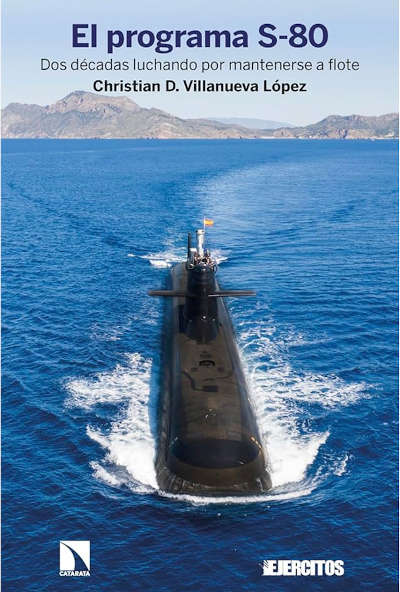In the image
Cover of the book by Christian D. Villanueva 'El Programa S-80: Dos décadas luchando por mantenerse a flote' (Madrid: La Catarata, 2023) 350 pp.
The work of Christian Villanueva, director of the digital magazine on armaments and strategic programs of study 'Ejércitos', is so far the most complete and documented account of the history of the S-80 program, from before it even began to run until the present day. The book is, in this sense, unique in its kind for two fundamental reasons. Firstly, because it is the first work to bring together the complete history of the program, from its development to the present day. No other work has ever covered so much about these submarines.
Secondly, for the great wealth of detail and the depth with which it addresses each of the aspects of the complicated history of the class Isaac Peral; however, the author himself acknowledges that there are still a lot of aspects that have not been published, which in no way detracts from the quality of the story.
Villanueva's work offers the reader a journey through the history of the program, from the real beginnings back in the nineties (when, as is recalled on several occasions throughout the book, the Navy was going through a true golden age) to practically the submission of the first unit, the S-81 'Isaac Peral' (which took place just a few months after the book was published), describing in detail the entire process of development and design, and the actors involved.
The work is structured in four chapters and an epilogue, each of which corresponds to a stage of the program. In the first, "the decision", Villanueva addresses the status of the Spanish Navy and naval power during the decades following the Cold War, a period that has had great influence on the current S-80 program. Among other things, the fundamental aspect of this period is none other than the discussion and subsequent decision in favor of separating from the French business DCNS to pursue an ambitious national project .
The book continues with the development phase of the program, in which the author discusses the details of the definition of the project and the problems encountered by the Spanish business Navantia along the way. These problems, partly due to business 's limited experience with submarines, eventually resulted in an error of design which, after several delays and associated setbacks, would eventually lead to the need for a new design of the platform under the name S-80 Plus. During this period, the capabilities and equipment that the future class would have on board were also defined, some of which place Spanish submarines among the most advanced conventional attack submarines in the world.
On the new S-80 Plus as it is currently being built, the third chapter is perhaps the most technical and specialized, dealing with the details of all the systems and equipment that the class carries on board, including the air independent propulsion system (AIP) and the onboard armament. Although this part is perhaps less suitable for those who are not so interested in the technical aspects as in the importance of the program in strategic-political terms, it is nevertheless one of the elements that make Villanueva's work a unique work in Spain, especially when many of the details of the program are not easy to find (and that is for those who are not strictly classified).
Finally, the last chapter makes a assessment of the impact of the program in several ways, emphasizing the lack of detailed information regarding industrial aspects. For obvious reasons, this section leaves out the first year of operational life of the first submarine of the class, the S-81 Isaac Peral, which was delivered to the Navy at the end of 2023, a few months after the completion of Villanueva's work.
Thus, as we say, the book is unique in our country, due not only to its capacity of analysis and the quality of the story, but also to the integration of all the factors that played some role along the development of the submarines.
All this is complemented with a critical radiography of the Spanish naval industry and the current status of the world of defense in our country. As the reader will see throughout the book, all the lights and shadows of the program have been, to a greater or lesser extent, influenced by the shortcomings of our naval industry and by the political vision of our national defense. And as the author emphasizes on many occasions throughout the book, it is precisely in the latter where our country has more work ahead of it if it intends to develop a solid projection capacity backed by a strategic conscience in accordance with the present time.
At final, the history of the S-80 program and Villanueva's work are elements of reference letter for the maritime world in Spain. The book is ideal for those who wish to obtain a multidimensional perspective of the technical aspects of the submarine, its capabilities and its raison d'être. But it is also destined to become a work of reference letter for all those who wish to better understand the importance for our country of having a strategic vision and leadership to strengthen our national defense and security interests, something that, for the moment, is still a pending task in Spain.

